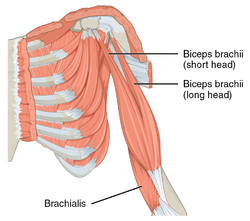Biceps brachii
| Biceps brachii | |
|---|---|

The biceps is a two-headed muscle and is one of the chief flexors of the forearm. Here is the left side, seen from the front.
|
|
| Details | |
| Origin |
Short head: coracoid process of the scapula. Long head: supraglenoid tubercle |
| Insertion | Radial tuberosity and bicipital aponeurosis into deep fascia on medial part of forearm |
| Artery | Brachial artery |
| Nerve | Musculocutaneous nerve (C5–C7) |
| Actions | |
| Antagonist | Triceps brachii muscle |
| Identifiers | |
| Latin | musculus biceps brachii |
| Dorlands /Elsevier |
m_22/12548475 |
| TA | A04.6.02.013 |
| FMA | 37670 |
|
Anatomical terms of muscle
[]
|
|
In human anatomy, the biceps brachii (/ˈbaɪsɛps ˈbreɪki.aɪ/), commonly known as the biceps, is a two-headed muscle that lies on the upper arm between the shoulder and the elbow. Both heads arise on the scapula and join to form a single muscle belly which is attached to the upper forearm. While the biceps crosses both the shoulder and elbow joints, its main function is at the latter where it flexes the forearm at the elbow and supinates the forearm. Both these movements are used when opening a bottle with a corkscrew: first biceps unscrews the cork (supination), then it pulls the cork out (flexion).
The biceps is a muscle in the upper arm with two heads, called the short head and the long head, which converge into a single mass. It is one of the three muscles in the anterior compartment of the arm, the others being the brachialis muscle and the coracobrachialis muscle, with which the biceps shares a nerve supply. Both heads of the biceps arise from the scapula in the shoulder, and the muscle attaches to the radius (bone), in the forearm. Specifically, the short head of the biceps originates from the coracoid process at the top of the scapula. The long head originates from the supraglenoid tubercle just above the shoulder joint. From here, the long head has a tendon that passes up along the intertubercular groove of the humerus into the joint capsule of the shoulder joint. The tendon of the short head runs adjacent to the tendon of the coracobrachialis and likewise attaches to the coracoid process.
...
Wikipedia
